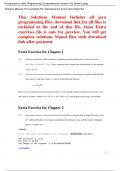Exam (elaborations)
Introduction to Java Programming Comprehensive Version 10th Edition By Daniel Liang (Solution Manual)
- Course
- Institution
Introduction to Java Programming Comprehensive Version 10e Daniel Liang (Solution Manual) Introduction to Java Programming Comprehensive Version 10e Daniel Liang (Solution Manual)
[Show more]



